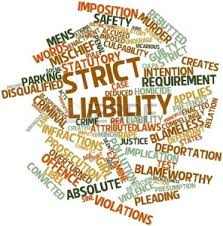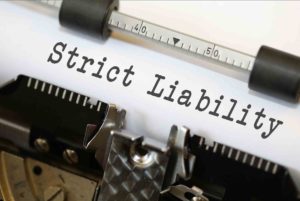Ryland v Fletcher (1868) L.R. 3 H.L. 330
Brief Facts of the Case
Rylands commissioned contractors to build a reservoir on his land in 1860, with the intention of supplying water to the Ainsworth Mill. Rylands did not participate in the construction process, instead of contracting it out to a qualified engineer. During construction, the contractors discovered a number of old coal mines and passages beneath the ground, which connected to Thomas Fletcher’s adjacent mine and were filled loosely with soil and rubbish.
The contractors chose to leave these shafts open rather than seal them up. Rylands’ reservoir burst shortly after being filled for the first time, flooding Fletcher’s mine, the Red House Colliery, inflicting £937 in damage. Fletcher pumped the water out, but his pump burst on April 17, 1861, and the mine began to flood again. A mines inspector was called in at this point, and the submerged coal shafts were located. Rylands and the landowner, Jehu Horrocks, were sued by Fletcher.
Issues
i.) Whether or not there was any nuisance caused?
ii.)Was Defendant’s use of his land unreasonable, and hence should he be held accountable for the Plaintiff’s damages?
Judgement
Justice Blackburn while deciding the case of Rylands v Fletcher in the Court of Exchequer Chamber observed that the correct rule of law was that if any person for his own intentions brings to his land anything or accumulates anything which has the potential to cause trouble in case it escapes, it must be kept at the person’s own risk and the person should be made liable for all damage caused by the natural escape of such a thing.
According to Justice Blackburn, a person who has brought a dangerous thing to his land can absolve himself of guilt by asserting defences such as that the escape was caused by the plaintiff’s default; or by establishing that the escape was a result of an act of God. The Exchequer Chamber court established a guideline for when an owner’s obligation for bringing any danger into his property can arise. At the same time, the court explored some defences that could help free the defendant of liability.
Rylands was found accountable for the damage done to the Fletcher by the Exchequer Chamber court. The defendants owed a duty of care to the risk, according to the court, because they were aware that if that amount of water leaked, it would be dangerous. The defendants showed a lack of care by holding such a large amount of water on their farm, which was an unnatural use of their land and thus they were held liable. This decision was upheld by the House of Lords. But the House of Lords added another requirement in the Rule of strict liability and stated that the land from where the escape takes place must have been altered in some way that would be regarded as non-natural, unusual, or inappropriate.
Analysis
The case of Ryland vs. Fletcher was pivotal in determining a property owner’s culpability for putting a harmful device into his property. A law that might raise the owner’s responsibility was required. So that he can be more cautious when bringing any potentially hazardous materials inside his home. The world is changing at a breakneck pace, and in this era of industrialization, privatisation, and globalisation, disputes over the duty of care are exploding at an alarming rate, necessitating the creation of legislation to address these issues. This strict liability rule discussed in this particular case opened the path for India’s ‘The Rule of Absolute Liability.’
T.C. Balakrishnan Menon v. T.R. Subramanian AIR 1968 Kerala 151
Brief Facts of the Case
A minimal gundu is an explosive produced by filling a coconut shell with explosive material. The coconut shell is inserted in a bamboo tube with cannon powder underneath, which is held upright by an iron peg driven into the ground. The coconut shell is thrown vertically several feet into the sky, where it bursts, producing a flash or lightning-like light and a loud report when the gun powder in the tube is ignited through a small hole on the tube’s side.
Two Devasworms, the Paramekkavu and Thiruvambadi organized two processions of elephants bearing the deity which was supposed to meet at the South Gopuram of the Vadakkunnatha temple at about 5 or 5.30. Just as the elephant of Paramekkavu Devaswom emerged through the Southern Gopuram bearing the deity, a few hundreds of olappadakkams (type of fireworks made with gun powder wrapped in small parcels of palm leaves) interspersed with 20 to 25 minnal gundus were fired which led to a massive accident.
Issue at Hand
The question, in this case, was whether the Volenti non-fit Injuria defence could be applied to this case, i.e., whether the appellants, who had engaged an independent contractor to attend to the fireworks display, were liable or not.
Judgement
As per the opinion of two lower courts, Minnal Gundu did not climb into the sky and detonate there, but instead departed down a tangent line, fell into the crowd, and exploded, gravely injuring the first defendant. Another conclusion is that the accident was caused by the twentieth defendant mistakenly incorrectly fastening the bamboo tube with coconut shell to the iron rod, as well as his negligence in selecting a permanent tube when the tube was damaged.
The court ruled in favour of the defendants, upholding the lower courts’ decisions, holding that the explosive, which was made out of a coconut shell, was a dangerous item whose use, even on the day of the festival, was a “non-natural” use of land because, according to the Indian Explosives Act, licences and permits are required for manufacturing and storing explosive substances.
Here the defence of volenti non-fit injuria was not considered a valid defence. The Court opined that anyone who was there at that large ground cannot be considered to have accepted to be there at their own will, even after the explosive fell outside the area of the cordon where the explosives originally exploded and landed, hence injuria cannot be applied to this case. Since the minnal gundu is an explosive, it is considered an “extra-hazardous” object, and those who use it, which by its own nature poses a special risk to others, must be held culpable for the negligence of the independent contractor they hired.
Analysis
This case played a crucial role in determining the responsibility of independent contractors while making non-natural use of land. This case made it vividly clear that no land can be used for non-natural purposes even if it is for a religious occasion.

Nichols v Marsland [1876] 2 Ex. D 1
Brief Facts of the Case
The defendant was the proprietor of a series of artificial decorative lakes that had been in place for many years and had never caused any damage prior to June 18, 1872. However, after a particularly heavy rainstorm, the lakes overflowed, the dams at their ends fell way, and the water from the lakes washed away the county bridges further downstream.
Issue at Hand
The court scrutinized if the defendant played a negligent part in causing actual injury to the plaintiffs.
Judgement
The jury came to the conclusion that there was no carelessness on the part of the defendant. A particularly strong rainstorm served as a sufficient reason as an act of God, allowing Rylands -v- Fletcher to avoid culpability. Acts of God are not the same as unavoidable accidents or the lack of negligence, and they never have been. The defendant could not have predicted the extraordinary flood that caused her dam to fail; her actions were not a direct cause of the plaintiff’s damages.
The last question is whether the defendant established that the water’s escape was caused by an act of God. Now, the jury has clearly found not only that there was no negligence in the construction or maintenance of the reservoirs, but also that the flood was so large that it could not reasonably have been anticipated, even if the effect could have been prevented if it had been anticipated; and this appears to us to be a finding that the water was released as a result of an act of God. The Court went on to say that the massive amount of water brought in by the flood is the single proximate cause of the water’s escape in law.

Rickards v Lothian [1913] AC 263
Brief Facts of the Case
The claimant rented space on the second storey of a building that was used for commercial purposes and operated a business from there. The defendant was the building’s owner. He rented out parts of the building to numerous businesses. The lawsuit arose after someone on the fourth level of the defendant’s building blocked all of the sinks in the toilets. The same person then turned on all of the taps, evidently with the goal of flooding the house and causing damage. The flooding on the fourth floor eventually spread to the second floor, causing damage to the claimant’s property. The claimant then began his case, stating that he had incurred damage as a result of the water escaping from the defendant’s premises, based on the rule in Rylands v Fletcher.
Issue at Hand
The question, in this case, was whether a judgement of non-natural use of land and Rylands v Fletcher responsibility might be made where an escape (which would ordinarily constitute such liability) was caused by a third party’s malevolent activities rather than the Defendants’. Also at issue was whether water could be viewed in this context as something that was not naturally present on the property but had been brought there by Defendant.
Judgement
The installation of a residential water supply to the premises was a perfectly normal use of the property. The Court noted that there is an additional point on which the current case does not fall under the Fletcher v. Rylands principle that the thing carried on to the defendant’s land should be something “not naturally there.” It is not every use of land that brings that idea into action. It must be a unique use that puts others in danger, and it cannot just be normal use of the property or use that is appropriate for the community’s overall benefit. A vandal blocking the sink and turning on the faucet was considered an act of God.
The provision of a sufficient supply of water to various parts of a house is not only reasonable, but has become an almost central feature of town life, according to prevailing sanitary views, and it would be wholly unreasonable to hold an occupier responsible for the consequences of acts over which he has no control.
Transco Plc v Stockport Metropolitan Borough Council [2004] 1 ALL ER 589
Brief Facts of the Case
The Claimant was the owner of a gas line that ran between Stockport and Denton beneath the surface of an old railway. The Defendant was the local council, which was in charge of a water pipe that served a block of flats on the Brinnington Estate. That water line developed a leak in 1992, which was subsequently repaired but not immediately recognised. The water had been leaking heavily (because to the pipe’s size) and had inundated the embankment where the Claimant’s gas pipe was located throughout that time. Because of the saturation, the embankment finally crumbled, leaving the gas pipe unsupported. This posed a serious threat, necessitating costly remedial work right away.
Issue at Hand
The question in the case was whether the rule in Rylands v Fletcher could be applied to this combination of facts and whether the council’s use of the land (to transport water to the housing estate) could be considered a non-natural use.
Judgement
The Rylands v Fletcher rule is still in effect as a remedy for damage to land or land interests. It does not apply to works or businesses that are authorised by law. It is not overly strict because it exempts accountability when the escape occurs due to the most prevalent causes, such as vandalism or extraordinary natural disasters. By the same token, circumstances, where there is an escape that is not due to an uncommon natural event or third-party conduct, will almost always lead to a conclusion of negligence.
There is an ambiguous exception for ‘natural’ land uses. It’s somewhat unsurprising that counsel couldn’t uncover a single example since World War II in which a claim under the rule had been successful. Asking whether the damage was insurable is a good indicator of whether there was a ‘non-natural’ user of land. Since there was no escape of a substance introduced onto the land, and Transco possessed an easement and so an interest in the land, liability was not proven in this case.
Analysis
This was a prevalent case that highlighted the fact that defendants would not be held liable if the escape of the potentially dangerous thing from their land is caused to extraordinary circumstances beyond their control.
Carstair v Taylor [1871] L.R. 6 Ex
The defendant rented the ground level of a building to the plaintiff. The defendant himself lived on the top floor of the building. Water kept on the top floor leaked without the defendant’s knowledge or consent, causing damage to the plaintiff’s items on the ground floor. The defendant was found not liable since the water had been stored for the advantage of both the plaintiff and the defendant.
M.P. Electricity Board v Shail Kumar AIR 2002 S.C. 551
In this case, a 37-year-old man named Joginder Singh was returning from his factory on his bicycle. A live electric wire had snapped and was lying on the road. The rain had fallen, and the road had become half-flooded. The cyclist was unaware of the electric line, and when he came into touch with it, he perished instantly from electrocution. The widow and small son of Joginder Singh filed a lawsuit against the M.P. Electricity Board. The Strict Liability rule was used, and it was determined that the Board had a legal obligation to provide energy in the region.
The electric supplier will be held accountable if the energy so conveyed causes injury or death to a person who is unwittingly trapped in it. The current should have been shut off automatically if the electric cable was snapped. Authorities in charge of such hazardous materials have a special responsibility to devise plans to avoid catastrophes.
The defence that the breakage of the wire was caused by a stranger attempting to steal the electricity was dismissed. The Electricity Board should have expected such an act, and at the very least, the appellant Board should have prevented the repercussions of the stranger’s behaviour.
Eastern and South African Telegraph Co Ltd. v Capetown Tramways Co. [1902] A.C. 381.
Electric current escaping from the defendant’s tramways disrupted the plaintiff’s underwater cable transmissions. Since the plaintiff’s apparatus was unusually sensitive, and such damage would not occur in a person going about their daily activity, the defendant was deemed not accountable for the escape. It was observed “A man cannot enhance his neighbour’s obligations by putting his own property to particular uses, whether for business or pleasure” owing to which the defendant was absolved of all liability.
Noble v Harrison [1926] 2 KB 332
It has been decided that having non-poisonous trees on one’s property is not a non-natural use of land. A non-poisonous tree branch growing on the defendant’s land that overhung the highway unexpectedly snapped and fell on the plaintiff’s vehicle travelling along the highway. A latent flaw had caused the branch to break off. The defendant could not be found accountable under the Rylands v. Fletcher test because tree-growing is a non-natural use of land. Growing a toxic tree, on the other hand, is not a non-natural use of land, and if an animal on the defendant’s land eats the poisonous tree’s leaves and dies, the defendant will be held accountable under the rule.
Madras Railway Co. v Zamindar [1974] 1 I.A. 364 (PC)
The Privy Council has ruled that, due to the unique conditions of India, the escape of water gathered for agricultural purposes may not be subject to severe liability. The owner of the land where such water is gathered is only accountable if he has not exercised sufficient caution. The breaking of two ancient tanks on the respondent’s zamindari resulted in the release of water in this case. These tanks, which had been there for a long time, were built not just for the defendant’s advantage, but for the benefit of thousands of his ryots as well. The escaping water caused damage to the appellants’ homes, as well as the destruction of three railway bridges.
The rule in Rylands v. Fletcher was not relevant in these circumstances, and because the zamindar was not careless, he was not accountable for the damage caused by the overflowing water.
